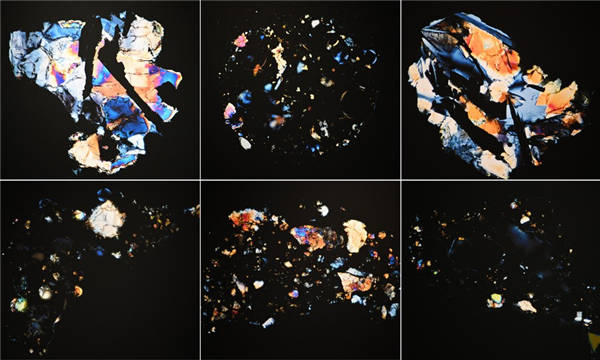
This combo photo shows cross-polarized micrographs of different lunar soil particles displayed at an exhibition themed on lunar soil research achievements in University of Science and Technology of China, in Hefei, east China's Anhui Province on April 19, 2023.(Xinhua)
A research team led by Chinese scientists has mapped the chemical composition of the lunar surface with high precision, providing key data for the study of the moon's evolution.
Lunar surface chemistry is essential for revealing petrological characteristics in order to understand the evolution of the moon.
Existing chemistry mapping based on the lunar samples collected by Apollo and Luna could only reveal the evolution of the moon 3 billion years ago, missing the critical late period.
The lunar samples brought back by China's Chang'e-5 mission, however, have been proven to carry information about young volcanic activity about 2 billion years ago and distinctive material composition.
The research team accurately estimated the content of major elements on the lunar surface by combining the sample data from Chang'e-5, Apollo and Luna with a deep learning-based inversion model, said Yang Chen, a professor at Jilin University.
They subsequently created a new lunar surface chemical composition distribution map with high precision and high resolution, which comprehensively reflected the chemical characteristics of the lunar surface.
The researchers also calibrated the young mare basalt units based on the newly calculated element content, which will provide reliable data for historical studies of magmatic activity and thermal evolution in the late lunar period and for future lunar sample return missions, Yang said.
The study was jointly conducted by Jilin University, the National Astronomical Observatories of the Chinese Academy of Sciences, the University of Trento in Italy, the University of Iceland and other Chinese and foreign research institutions.
Ouyang Ziyuan, a leading Chinese scientist and the first chief scientist of China's lunar probe project, was also involved in the study.
The study was recently published in the journal Nature Communications.

- Scientists map chemical composition of lunar surface
- China publishes new datasets obtained by Mars, lunar probes
- Chinese scientists synthesize sugar from carbon dioxide
- China to realize manned lunar landing by 2030
- Lunar glass makes moon building program feasible
- Scientists discover prehistoric carnivorous giant panda
Popular Videos
Hot comments
- China Life: Chinese women shine with She Power
- First apes at U.S. zoo receive COVID-19 vaccine made for animals, zoo official says
- 86-year-old grandma in Hebei spends most her life on traditional cheongsam
- Homemade curling videos trending in China
- Outstanding Chinese women
- Asia is young!
- Three Chinese lithium companies pursue secondary listings in Europe
- Lantern Festival: A romantic celebration in China
- 6-year-old Chinese boy becomes youngest Rubik's Cube player for A-level
- Xi arrives in San Francisco for talks with Biden, APEC meeting
Top Reviews
- Fly over newly-opened Lijiang-Shangri-La railway
- Scientists map chemical composition of lunar surface
- Xi chairs leadership meeting on Yangtze River Economic Belt development, CPC leadership over foreign affairs
- China's 2024 national civil servant exams begin
- China to pilot community-level embedded service facilities in about 50 cities
- Malaysia to open 30-day visa free travel for Chinese citizens
- Water Festival, revival of centuries-old boat race tradition in Cambodia
- Bridge offers trial run of group tour next month
- Flu peak may last another one or two weeks
- 1st world conference on forestry opens in Nanning







